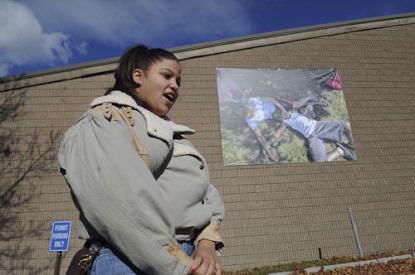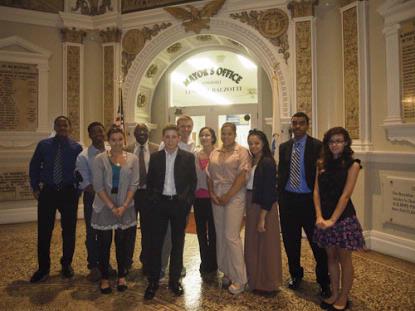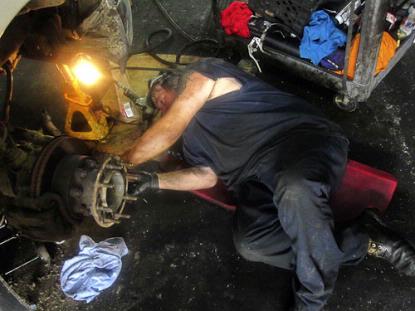
If you walk along Main Street in Brockton’s downtown, you will see huge photographs, printed on banners and hanging from buildings. They were made by Brockton teens as part of the City of Champions: Youth Vision in Context project. “It’s like an Easter egg hunt,” said one visitor on a walking tour of the installation, as we turned corners and discovered new photographs.
The seeds of the project were sown in September of 2011, when twelve of my photographs were installed as banners on buildings in Brockton. I had been photographing in order to understand Brockton’s changing cultural identity, and decided that a public installation of the work might pull viewers into the city. I wanted them to consider the history of our post-industrial landscape, and to meet face-to-face with its residents, who are so often eclipsed by negative imagery and stereotype.

With the support of Mass Humanities and the Office of Mayor Linda Balzotti, the photographs were installed. They were scheduled to be displayed for a year, amid walking tours and lively public forums. By January, people were asking what would happen when they were removed: “It’ll feel like when you take down the Christmas decorations,” said one resident, sadly.
George Mallett, at Artists for Humanity, reminded me that I had carved out a platform to consider Brockton in new ways, and that it was important – and possible – to keep this momentum going. I began to think about Brockton’s young people, to wonder how their vision might further illuminate our understanding of Brockton and cities like it
Again, with generous support from Mass Humanities and the Office of the Mayor, and with a great team assembled from Artists for Humanity, the Brockton Redevelopment Authority, and Brockton Community Schools, we devised a course for the summer: of Champions: Youth Vision in Context. Twelve high school students, Brockton residents, would spend the summer photographing their worlds. Their best work would be submitted to the Mayor for review, and thirteen of their photographs would replace mine on the buildings. (And, thanks again to Mass Humanities, the students would even be paid a stipend for their work.)
Essential to the project was Willie Wilson, Jr., Brockton’s beloved local historian and veteran teacher. Together we felt that these young photographers needed to understand the city’s rich history, and to see themselves as an integral part of that history. So, while I taught the principles of narrative photography, urging students to see the stories all around them, Willie taught the basics of Brockton history, focusing on race, economics, labor, and immigration.
Week after week, the students photographed – some with cameras of their own, some with cameras on loan for the summer. I asked them what they would like to portray – show me what you love, what you hate, what you would like to change about this place – but to a person, each of them said that they wanted to show the beauty: what people don’t see, don’t understand about Brockton.
Toward that end, we talked about photography in a number of ways: the mechanics, yes, of framing and moment and composition and color. But, also, we talked about the difficult, gritty parts of the practice: How do you push yourself beyond your comfort zone? How do you approach strangers and reveal something honest about your encounter? How do you create feeling, texture, and mood in an image? These were ideas that were new to our students, and they gobbled them up.

The work they did, the slices of life they brought back, thrilled us all. Jonathan photographed his mother, deep in thought, amid the beauty of D.W. Field Park. Kevin photographed his brother, illuminated by a streetlight, walking home from an evening service at their Haitian church. Heather photographed a friend of the family, a man of Greek descent, wearing oily clothes and fixing a car. Students photographed friends and strangers, critiqued each other’s work, photographed some more. They learned about the shoe factories of the last century, the waves of European immigrants who settled the city, the African-American community that had taken root there. They never missed class. They paid attention.
Ashley, a young man born in Haiti, rang the doorbell of his next-door neighbor, a woman who had lived in her home for four decades, in what is known as the “old Lithuanian village.” They had never met. Over a pitcher of iced tea, they shared their own personal slices of Brockton history, and he made portraits of her. In the photographs you can see her comfort with him, her growing affection – a human connection. She came to the opening of our installation, met the other students, praised her neighbor. They had become friends.
Michael arrived in class one day with no new pictures – this had never happened before. We stood toe-to-toe, neither of us happy. I instructed him to put down his things, pick up his camera, walk around the block, and photograph what he found. I told him he could be mad at me later, but for right now he had to make himself available to what he might find. A half-hour later he returned with portraits, of a man at work in the street. The composition was simple, and elegant. The man’s expression was open, his body relaxed, as though he had completely surrendered to Michael’s artistry. We all cheered, clapped Michael on the back. We agreed it was one of his strongest pictures.
At the end of the summer I phoned the man in the photograph, to obtain his permission to appear on a banner. He agreed, and told me how much he admired Michael: his politeness, his professionalism, how difficult it must have been to approach a stranger. Another connection had been made.
The camera is magic. It invites us to explore, to cross doorways, to start conversations. It allows us to share what we notice, how we see, what matters to us. It gives us a springboard from which we can ask critical questions about our world: Who shares this space with us? How does it feel to live here? What are our common concerns, and what issues divide us? Can we see each other, as fellow human beings?
I hope you will come to Brockton to see the city, as our students did last summer.
* * * *
See slide-show of more images in the Photo Gallery to the right of this essay. The full portfolio of student work is available at www.cityofchampionsproject.com. The banners will be on display until September of 2013.


